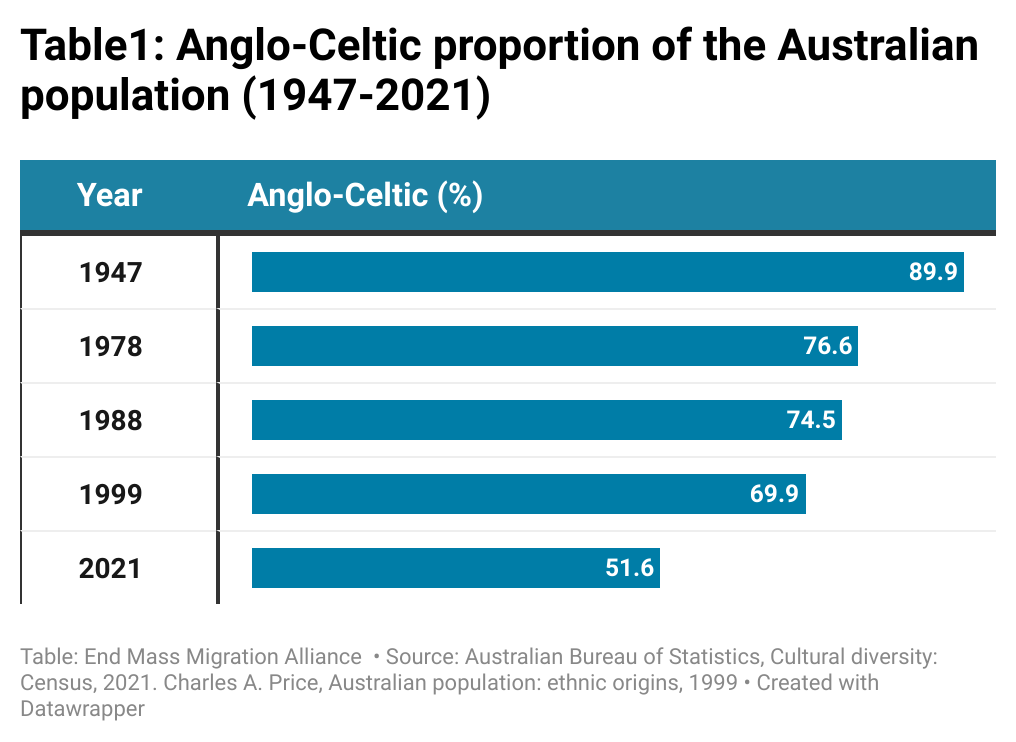Overview
Demographers have projected that Australia could maintain a stable population size with net overseas migration (NOM) set at about 100,000 per year. At these levels of NOM, it’s also possible to achieve steady economic growth.
However, the main Australian political parties reject this moderate immigration policy. Why is this?
Perhaps attracting more votes from ethnic communities is the key reason the main parties remain committed to mass immigration.
There are many potential Asian voters who will be enticed by an immigration policy that is focused on bringing in large numbers of migrants from Asia.
What is beyond doubt is that bipartisan support for mass immigration has resulted in Australia's population becoming more Asian and less European.
Introduction
There was a fascinating discussion on 2GB Sydney Radio with host Mike Jeffreys and the respected Australian economist Leith van Onselen (LVO).
The controversial issue of the Asianisation of Australia was discussed.
LVO makes regular appearances on Australian media. He provides great commentary to the general public about Australia’s huge migration intake. And the effects of this on the community and economy.
He provides a sweeping examination of all issues related to large-scale immigration such as housing supply, rising unemployment, lack of infrastructure etc.
His principal argument is that keeping NOM around 100,000 per year is an optimum immigration and population policy for Australia.
The Asianisation of Australia
The Asianisation of Australia has remained a controversial issue going back to the 1990’s. Around that time, One Nation opened up the debate about the effects of Australia's open immigration policy on the racial make-up of the country.
Since that period, Asian immigration has accelerated.
In 2022-23, the top 3 countries of birth contributing to NOM were India, China and the Philippines (see Figure 1 below). And this continues the trend of the previous decade.
Given the rapid increase in Asian immigration. It’s hardly surprising the issue of Asianisation has reached the stage where mainstream media are willing to discuss how quickly this is changing Australia’s demographic make-up.
In the 2GB interview, the host referred to an Asian friend who is working in Australia as an engineer. Quoting from the Asian person who said, “I don’t know why Australia needs to go through a process of Asianisation.”
What is indisputable, is that large-scale immigration has produced a rise in the Asianisation of Australian cities and suburbs.
Over the past 20 years, the enormous increase in migrants from Asian nations and other non-European nations has given rise to different and distinct residential settlement patterns in all major Australian cities.
Demographers call these new settlement patterns “ethnoburbs”. Australian suburbs with large migrant populations.
When asked about the Asianisation of Australia. LVO’s answer was purely based on statistics:
“I mean just factually most of our immigration comes from India and China. So just based on statistics. Yes, we are.”
Based on the data alone, LVO acknowledges that Australia is going through a demographic process of Asianisation.
As was mentioned before, LVO has a significant media profile. And the potential to exert influence on politicians that are willing to listen to his commentary and explore his policy ideas.
In this interview, LVO stated that he is not concerned about the nationality of new migrants. He makes no mention about the magnitude of non-European immigration, which has resulted in a dramatic decline in the Anglo-Australian portion of the population (see Table 1 below).
However, the statistical evidence of population replacement is beyond doubt. Take New South Wales as an example.
In 2022-23, one hundred per cent of NSW population growth came from net overseas migration. In the 2022-23 financial year, NOM shot up by a very large 176,000 new overseas migrants (see Figure 2 below).
Sydney lost about 35,000 people aged 30-40, between 2016 and 2021.
Young Australian families are leaving Sydney due to high housing prices. And they are being quickly replaced by overseas migrants.
Demographic replacement
In 2022, the Albanese government embarked on a mission to massively increase NOM, which reached 518,000 in the 2022-23 financial year.
This is the highest NOM on record for a financial year, and by a significant margin.
In the 2021 Census, 17.4% of the Australian population identified as Asian.
The major share of the Asian population in Australia are people who originate from India and China.
In the 2011 Census, this portion of the population was 5.84%, rising to 8.55% in 2021.
The trend towards non-European immigration has increased significantly since the start of the 21st century.
At the current high rate of demographic change, within a few years, people identifying as Asian will comprise one in 5 of the Australian population.
On the other hand, there has been a major decline in the Anglo-Australian share of the population (see Table 1 below).
Mass immigration, since the start of the 21st century, is edging the Anglo - Australian ethnic majority closer to becoming a minority in the nation their ancestors founded and developed.
The demographic replacement of European Australians is the most important issue facing Australia. Large-scale immigration represents an existential threat to Australia’s European national identity and culture.
A recent survey revealed that a majority (53 per cent) of voters think that greater cultural diversity is a threat to Australia’s own culture and identity.
The onset of much higher NOM at the start of the 21st century, has radically transformed the ethnic composition of the Australian population.
It’s clear in polls and surveys conducted over the years that many Australians dread reaching a “majority minority” situation. And rightly so.
This is the moment when the majority ethnic group, becomes one of the multiple minorities.









Either we take steps now to protect our European identity or we will be replaced completely in a very short time. England’s three largest cities, London, Birmingham and Manchester now have minority white populations.